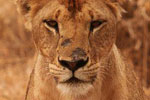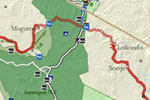
Zebras in the Ngorongoro Crater, a part of the Greater Serengeti Ecosystem. Photo by: Rhett A. Butler.
Illegal hunting in Tanzania’s Greater Serengeti Ecosystem (GSE) remains a prevalent activity for local people, despite government regulation and grassroots movements to prevent it. A new paper from mongabay.com’s open-access Tropical Conversation Science examines the factors that drive poachers to continue their activities, despite the high costs involved. By interviewing citizens involved with illegal hunting in the Western part of the Serengeti, they were able to identify key risks that are faced by the hunters as well as the perceived gains of a successful hunt.
The western side of the Serengeti has higher levels of illegal hunting because of the increased human population density. The researchers estimate that 52,000 to 60,000 illegal hunters live within 45 kilometers west of the GSE, and those numbers continue to grow as the population in Tanzania grows. While the factors affecting such a large population will be diverse, there are many that have been identified as recurring.
Such factors can impact both the long and short-term choices of poachers. For example, a farmer may choose to illegally hunt less often one year because a consistent income removes their need for extra food or money, but a year with excessive drought may drive him to hunt in the GSE several times a month for animals. Other factors include livestock/crop losses, costs of bridewealth for marriage (dowry), educational costs, culture, value of a resource acquired or simply a greater amount of herbivores in the area.
Because most GSE poachers use wire snares to capture wildlife, they do not necessarily control what wildlife they catch. The researchers write “even though snares often target large herbivores, unselective harvesting occurs and many carnivores such as lions and leopards are unintentionally killed in the process.” Hunters also use pit traps, dogs, spotlighting, and bow and arrows to hunt silently.
The Tanzanian government has prohibited poaching in protected areas like the GSE. Patrols both inside and outside the park have the legal power to arrest poachers and grant jail time or fines to hunters; however, this method relies on the ability to catch the poacher in the act. Many poachers set up their silent wire snares in the dark of night and are unseen by the patrols. In addition, often poachers will continue to hunt even after they have been caught because their bounty is worth more than the punishment. Researchers found that 84% of their 104 interviewees saw poaching as a difficult activity: aggressive wildlife, retrieval of wildlife, concealment, hostile contact (with neighboring Maasai) and punishment upon detection are all threats that poachers face each time they choose to hunt. A third of the respondents said that they had been injured by these activities.
Prison sentences and fines are meant to deter poachers. In the research sample, however, they found that poachers averaged 0.04 days in prison for all days spent hunting and had been arrested 1.4 times over an average of 1,901 days. This means that the average poacher has a 0.07% chance of getting caught. Over half of the sample had paid a fine for poaching, which averaged $39.00. When taken into account the amount of days spent poaching, a hunter averages $0.02 worth of fines every trip, a small cry from the value of the hunted goods which often add $307 to the hunter’s income.
“If the rewards poachers face are significantly greater than the financial, physical, or psychological risks involved, it is unlikely that the level of poaching in western Serengeti will decrease appreciably. Understanding the magnitude of these factors is therefore critical to understanding and predicting future success of conservation initiatives” note the researchers.
The researchers hope that increased anti-poaching enforcement will help maintain wildlife populations. But they also warn “if poverty is indeed the driving force of poaching and human population densities continue to grow, it is unlikely that such a lucrative enterprise as poaching will subside, even if significant increases in anti-poaching efforts are made.” They also hope that community- and incentive-based programs will continue to grow and people will “receive and perceive tangible benefits from conservation”.
CITATION: Knapp, Eli J. 2012. Why poaching pays: a summary of risks and benefits illegal hunters face in Western Serengeti, Tanzania. Tropical Conservation Science Vol.5 )4_:434-445.
Related articles
Poaching in the Serengeti linked to poverty, high legal hunting prices
(07/09/2012) In the effort to protect the Serengeti—arguably Africa’s most famous ecosystem—one of the major problems is the bushmeat trade. Population growth, little available protein, poverty, and a long-standing history of hunting has led many communities to poach wildlife within Serengeti National Park. Interviewing over a thousand community members in the western Serengeti, scientists found that community members are largely aware that wildlife hunting is illegal and that conservation of wild species is important, but hunt animals anyway partly out of necessity.
Legal case against Serengeti road moves forward
(03/21/2012) A regional case against the construction of a proposed road through Serengeti National Park has moved to trial after a judge with the East African Court of Justice (EACJ) threw out concerns by Tanzania reports the Daily Nation. The government of Tanzania has proposed a controversial highway that would bifurcate the northern part of the Serengeti National, only to see their plans stalled by a lawsuit filed by the Kenyan-based NGO, Africa Network for Animal Welfare (ANAW), which argues that the road could have massive consequences for the entire Serengeti ecosystem, a view shared by many scientists.
Richard Leakey: ‘selfish’ critics choose wrong fight in Serengeti road

(07/02/2011) The controversial Serengeti road is going ahead, but with conditions. According to the Tanzanian Minister for Natural Resources and Tourism, Ezekiel Maige, the road will not be paved and it will be run by the Tanzanian park authority who will have the power to monitor traffic to ‘ensure no harm comes to the wildlife population’. Critics argue that even an unpaved road would eventually cripple the largest land migration in the world. However, famed Kenyan conservationist, ex-politician, and anthropologist, Richard Leakey, told mongabay.com that critics of the road are focusing on the wrong fight while failing to respect Tanzania’s right to develop. Leakey says that instead of attempting to stop the road from being built, which he believes is inevitable, critics should instead focus on funding a truly wildlife-friendly road.
Unpaved road through Serengeti to progress

(07/02/2011) After a week of confusion, the Tanzanian government has finally clarified its position on the hugely-controversial Serengeti road. The Minister for Natural Resources and Tourism, Ezekiel Maige, confirmed that a paved highway will not be built through the northern Serengeti National Park, however the government is still planning to construct a gravel road through the park. Yet critics have long warned that even an unpaved road would open Pandora’s box: eventually commercial and population pressure would push the road to be paved, widened, and fenced leading to a collapse of the world’s largest remaining-and most famous-land migration. Two million wildebeest, zebra, and Thomson’s gazelle pass along this route in annual migration from Tanzania to Kenya.













